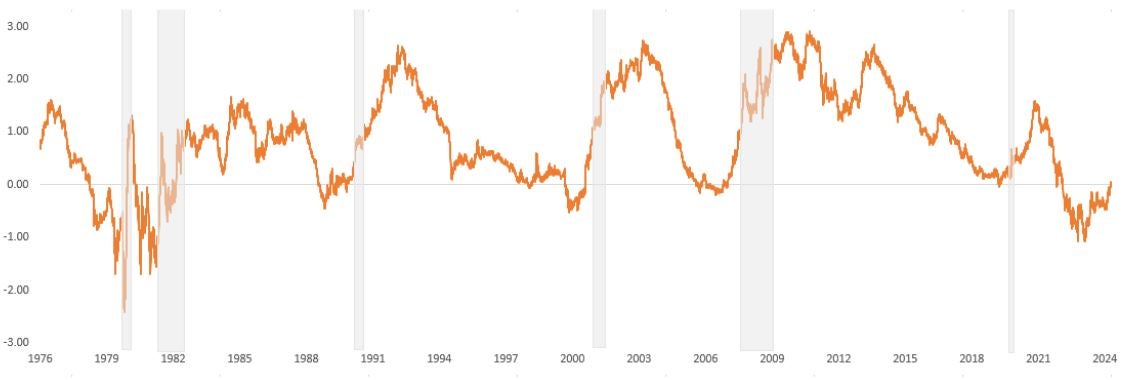
The yield curve flipped in anticipation of rate cuts, but that doesn’t mean a recession is imminent. To the contrary, we’re excited about opportunities tied to higher-income consumers and consumer staples, among others.
What happened to the yield curve?
After remaining inverted for over two years, the 2yr-10yr yield curve flipped back (or “disinverted”) last week (see chart).
Conventional wisdom says that a yield curve disinversion usually signals a recession. That’s because shorter-term bond rates tend to fall when the Federal Reserve lowers policy rates in anticipation of an economic slowdown.
But in our view, that’s not what’s happening this time around, so it’s important to understand what the Fed is thinking before making your own asset allocation decisions.

As of 09/09/24. Source: Federal Reserve Bank of St. Louis. Shaded areas indicate U.S. recessions.
Here’s what does (and doesn’t) matter
The Fed isn’t cutting rates to switch to an accommodative stance. Instead, it signaled that a change in its policy stance is warranted now that inflation is sustainably lower (the stable prices side of its mandate) and to stem further weakness in the labor market (the employment side of its mandate).
Keep in mind that even after the Fed cuts rates, the policy rate will still be above the perceived neutral rate. So monetary policy will still be restrictive—just less restrictive. However, the Fed risks moving too slowly or misjudging incoming economic data.
While some market watchers are concerned, we identify three key reasons why this does not necessarily signal an impending recession:
- The recent rise in unemployment is attributed more to an increase in labor supply, largely from immigration, rather than a collapse in demand for labor. Though we have seen some softening in demand (e.g. fewer job openings), we do not foresee unemployment escalating uncontrollably.
- While there is some stress on lower-end consumers, higher-end consumers—having generated tremendous wealth from asset appreciation and higher real incomes —should continue to spend.
- Economic growth remains close to its trend and 2Q24 GDP was revised up to 3%. Even if there's a slowdown towards the year's end, we anticipate the economy will continue to expand.
Voya IM’s views on positioning
Fixed Income
We favor investments tied to higher-income consumers. In addition, we continue to like duration and credit spread as we are not expecting a default cycle. We also believe opportunities further out on the curve, which had been less attractive when the curve was inverted, will arise.
Equity
We expect the trend of broader participation into more defensive sectors, which began earlier this year, to persist.
Multi-asset
We continue to overweight US equities with a bias towards higher quality areas of the market while remaining cognizant of any risks or opportunities that may arise.
